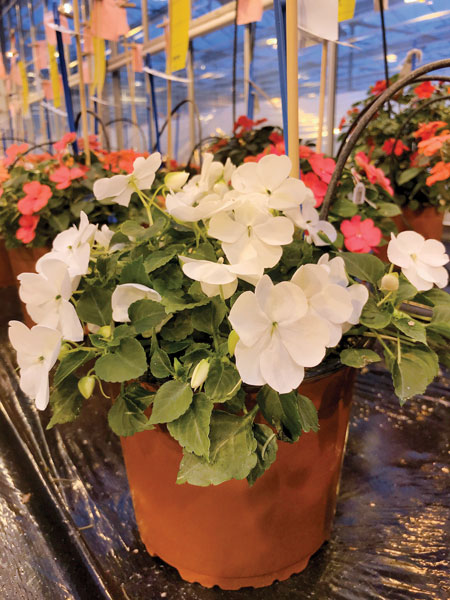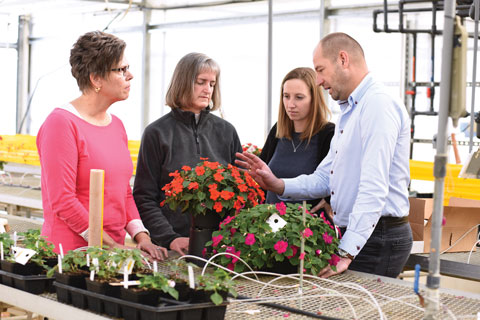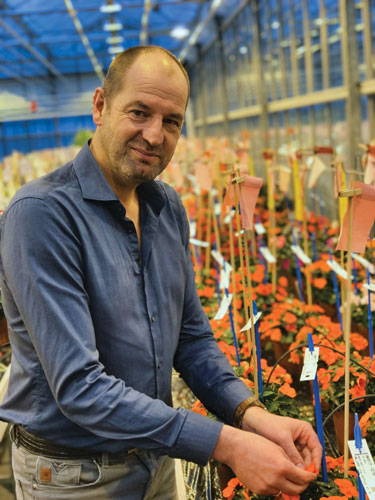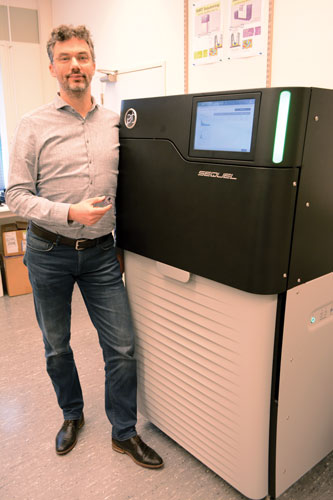3/1/2018
Bringing Back Impatiens
Chris Beytes

Look closely at the pretty white impatiens you see on the facing page. Appears delicate, doesn’t it? But don’t be fooled: This plant is carrying the weight of the entire bedding plant industry upon its petals. Or more precisely, upon its genes. Because this unremarkable-looking plant is the first generation of Impatiens walleriana to have been bred to resist the disease that devastated its forebears.
Bred in the Netherlands by PanAmerican Seed’s Ruud Brinkkemper and his team there and at PanAmerican’s Elburn, Illinois, facility, the new impatiens boasts “high resistance” to impatiens downy mildew, or IDM, the disease that has taken an estimated 50% to 60% out of the worldwide impatiens market (as much as 80% in the UK and 40% in the U.S., according to one seed company expert).
The term “high resistance” isn’t marketing speak, either; it’s an official description by the International Seed Federation, meaning, “Plant varieties that highly restrict the growth and/or development of the specified pest and/or the damage it causes under normal pest pressure when compared to susceptible varieties.” The only ISF definition that’s higher is “immunity.”
Pictured: This impatiens—or more likely one of its siblings—will be the first of a downy mildew-resistant series. If all testing goes as expected, PanAmerican Seed will introduce it to the trade in 2020.
If all goes well, this new impatiens series is expected to be launched commercially by PanAmerican Seed in 2020, with much trialing taking place between now and then.
It’s significant to note that the new impatiens is the first annual—maybe the first floriculture crop, period—to have been bred using a combination of “phenotyping” and “genotyping.” Phenotyping is the traditional way of determining if a new plant has the traits you are seeking—color, habit, seed quality, flavor, disease resistance and so on—by using your eyes, your other senses and various physical measurements. Genotyping, conversely, relies on reading the genes of the plant to search for specific markers that indicate the desired trait is there (more on this in a bit).
First, though, you need resistance to the disease and that can come from only two sources: either find a plant within the species that naturally exhibits resistance; or cause a desired genetic mutation to occur, using chemicals or radiation. Mutations happen all the time—think of the thousands of identical plants in your greenhouse and then you spot one that’s a different color. However, if mutating for disease resistance were easy, it would have already been done.
As for how and where PanAmerican found IDM resistance it’s using to create this series? Ruud remained extremely tight-lipped, for obvious reasons. We couldn’t pry it out of him with pliers.
History of IDM
The source of impatiens downy mildew is equally mysterious. How could a plant like impatiens, for decades the colorful darling of the shade garden, suddenly be wiped out by disease—and not just in one region, but in numerous countries, and at almost the same time? Nobody knows, although exceptionally cool, wet weather in Europe and Hurricane Irene in the eastern U.S. have been implicated, as has I. walleriana’s wide use and high susceptibility to the disease.
 Pictured: The new impatiens series is a team effort between PanAmerican’s Venhuizen and Elburn locations. Key personnel include global product development manager Lisa Lacy, plant pathologist Dr. Colleen Warfield and breeder technician Simone Crain, pictured here with Ruud Brinkkemper.
Pictured: The new impatiens series is a team effort between PanAmerican’s Venhuizen and Elburn locations. Key personnel include global product development manager Lisa Lacy, plant pathologist Dr. Colleen Warfield and breeder technician Simone Crain, pictured here with Ruud Brinkkemper.
Impatiens downy mildew—Plasmopara obducens, a disease caused by a fungus-like organism—has been known since the 1940s to exist in American soil. But it’s chosen to lay dormant, with few cases reported. Meanwhile, in the 1960s, the first modern F1 impatiens, Elfin, was bred in Costa Rica by Claude Hope. Soon after came Super Elfin, Accent, Tempo, Cajun and scores more series. The impatiens, with their colorful flowers and shade tolerance, soon became the most popular annual among consumers. And among growers, too, because their high germination, uniform habit and fast-finishing speed made them highly profitable.
But in the late 2000s, they started dying in landscapes in South Africa and the UK. A year later, the U.S., especially the Southeast and East Coast, was hit. Pathologists were at a loss, as were breeders, distributors, growers and retailers, who saw sales slump as news of the disease made headlines and consumers and landscapers got gun-shy. Whole new garden center departments of shade alternatives sprang up—good news for begonias and New Guineas, certainly, but not for the cheerful, ubiquitous I. walleriana, which was relegated to baskets, combo planters and those few markets where the disease was less prevalent.
Naturally, every impatiens breeder was being asked by his or her boss, “Can you breed an IDM-resistant impatiens?” The answer was always “It’s not that easy.” What was required was the resistant gene.
With that secret source to cross with, Ruud finally had a way to bring resistance into the crop. He began breeding in earnest in 2014, using classical techniques of crossing, producing seed, growing out seedlings, testing for the IDM-resistance trait and breeding some more.
Enter KeyGene
Keep in mind, the story thus far still has nothing to do with genotyping-based technology. Ruud’s breeding effort up until 2017 depended solely on classic techniques. However, PanAmerican Seed’s parent, Ball Horticultural Company, knew that genotyping—using gene markers to indicate that the trait was present—would greatly speed up Ruud’s breeding work. Instead of growing out every seedling to enough maturity to infect with the disease and test for resistance, he would only have to grow the seedling long enough to get a leaf sample, which could be quickly tested for the presence of the IDM-resistant gene. But to do that, you first have to “sequence” the gene of the impatiens and that takes a specialist.
KeyGene is just the company for the job. Founded in 1989 by five breeding companies with activities in field crops, vegetables and potato breeding (one, Royal Sluis, also had activities in floriculture), KeyGene’s specialty is developing and applying DNA-based technologies for agricultural crops and helping breeders take advantage of the resulting data. (Which is considerable, by the way. Did you know that a typical plant has about 30,000 genes in its genome, while we humans only have about 20,000?)
 The Ball/KeyGene partnership to sequence the impatiens genome began in 2016. We got a tour of their Wageningen, the Netherlands, facility with Robert van Tuil, Director of Business Development, who explained the process.
The Ball/KeyGene partnership to sequence the impatiens genome began in 2016. We got a tour of their Wageningen, the Netherlands, facility with Robert van Tuil, Director of Business Development, who explained the process.
Gene sequencing is very different today than it was in 2003, when the human genome was first sequenced. That process took many big machines (about the size of a commercial photocopier) running for several years. KeyGene has one of those machines, which they still use today, but not for genome sequencing.
Pictured: Ruud Brinkkemper, General Manager and Regional Breeding Director for PanAmerican Seed/Kieft Seeds in Venhuizen, the Netherlands.
Today, KeyGene uses so-called next-generation sequencing technology. They’re still big machines, but ones that can do the job in a few days instead of a few years and in much higher quality. Instead of two years, it takes as little as a few days or maybe a few weeks. And with multiple (upwards of 100) repeated readings of the genome and “long-read” technology that reads bigger pieces of the genome at once, the accuracy of the resultant sequence is much higher. Tomorrow? Picture a device about the size of a candy bar, connected via USB cord to a desktop computer, and you’ll know how quickly the technology is evolving.
The sequence, however, is just so much data. Stitching all the small sequence pieces together to the full genome and identifying or “mapping” which parts of the genome contain information that corresponds for the final properties of the plant (genes) is the work of a room full of refrigerator-sized computer racks and some very smart scientists. Robert spent a good bit of time explaining the process with the aid of a flip chart and marker, and even this C-minus biology student managed to grasp the fundamentals. Suffice it to say that, while it can be hard to identify exactly which gene does what in a plant, you can find small differences in the sequences between two plants. These are called “markers” and they’re always present if the trait is present. This is the basis of genotype breeding.
 Pictured: KeyGene’s Robert van Tuil with the sophisticated equipment required to generate a genome sequence.
Pictured: KeyGene’s Robert van Tuil with the sophisticated equipment required to generate a genome sequence.
The benefit to Ruud and his team’s classical breeding program is speed. Say he makes 100 crosses and gets seed from them all. He sows the seed, waits for them to germinate, then sends a tissue sample from each seedling down to KeyGene for testing (right now PanAmerican doesn’t have the capability to do their own testing, but that could change in the future). That same day, or within a few days, they can tell Ruud exactly which of the 100 seedlings is carrying the IDM-resistant gene. He can grow those out and discard the rest, saving time and effort.
This applies to any other genetic trait you can think of. IDM resistance is useless if you can’t produce the plants or if consumers don’t want to buy them. Ruud’s IDM-resistant plants must be attractive and floriferous, in bright, clear colors, and they need to make lots of high-quality seed. Genotyping will show Ruud which of his seedlings carry the desired traits much more quickly than the traditional method of growing out each trial for phenotyping.
That said, both processes are taking place with the new impatiens, which has been, and will continue to be, trialed extensively in the Netherlands and the U.S., with as much disease pressure being thrown at the series as possible.
As for the series itself, it originates with the Super Elfin series, Ruud says. However, don’t expect an exact replica of Super Elfin, including all 25 colors, since it does include some new parentage. The series will probably start with four to six colors (we saw about that many and they all looked fine) and most likely never extend as far across the spectrum as previous impatiens series.
What of the future of impatiens?
That leads to an important question: If the IDM-resistant impatiens is truly a success in the landscape, will impatiens once again become the world’s favorite annual bedding plant, with big banks of them growing in every shady landscape? Or has the market changed in the six or so years that impatiens have been hobbled by disease? Does the new impatiens need to take the form of the old one—flats and six-packs in dozens of shades of similar colors? Or will the market want just 10 colors grown in 4-in. pots? Only time will tell, but we hope that positive news of a disease-resistant impatiens will spread as quickly and as widely as the disease—and the bad news—did. GT